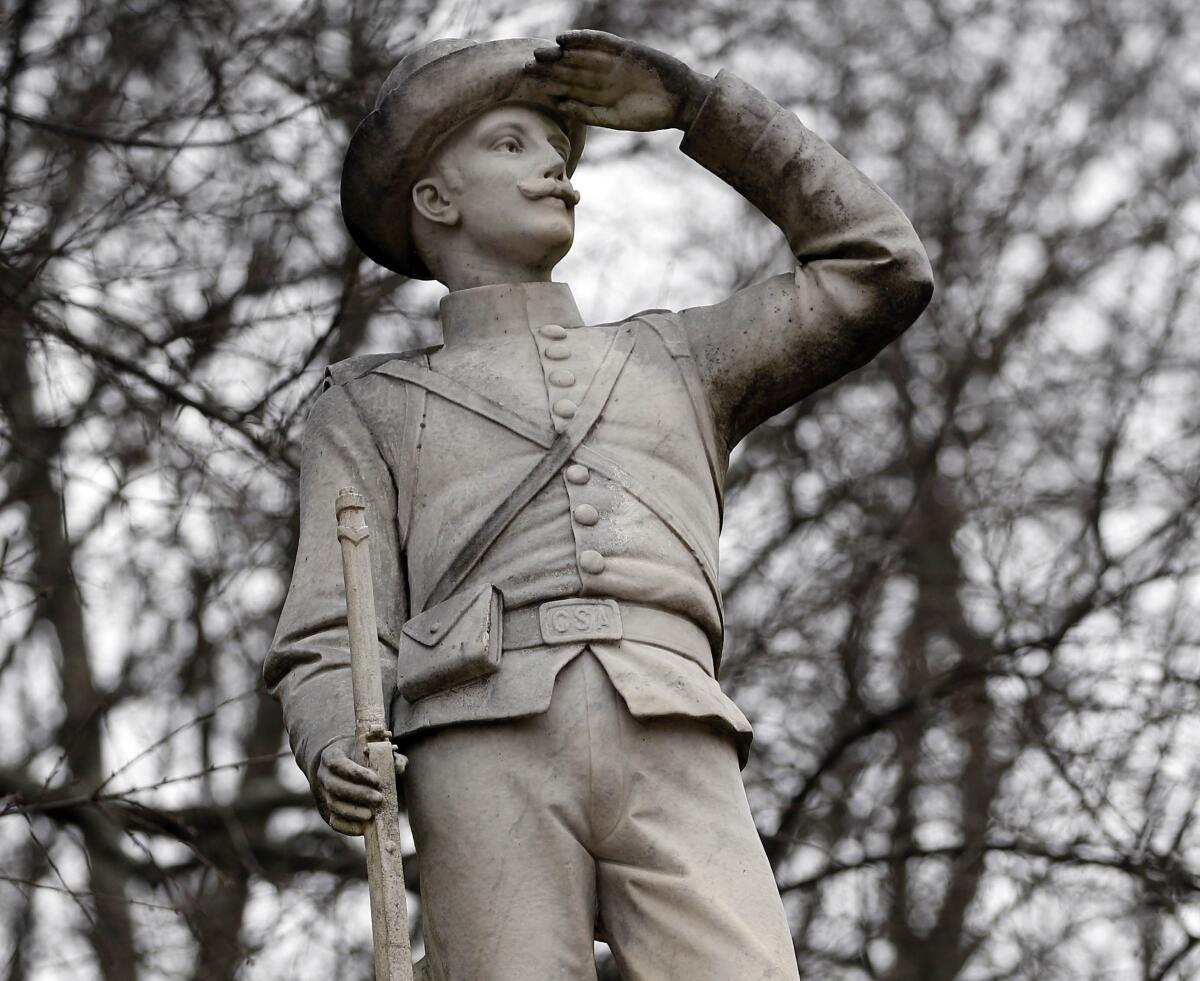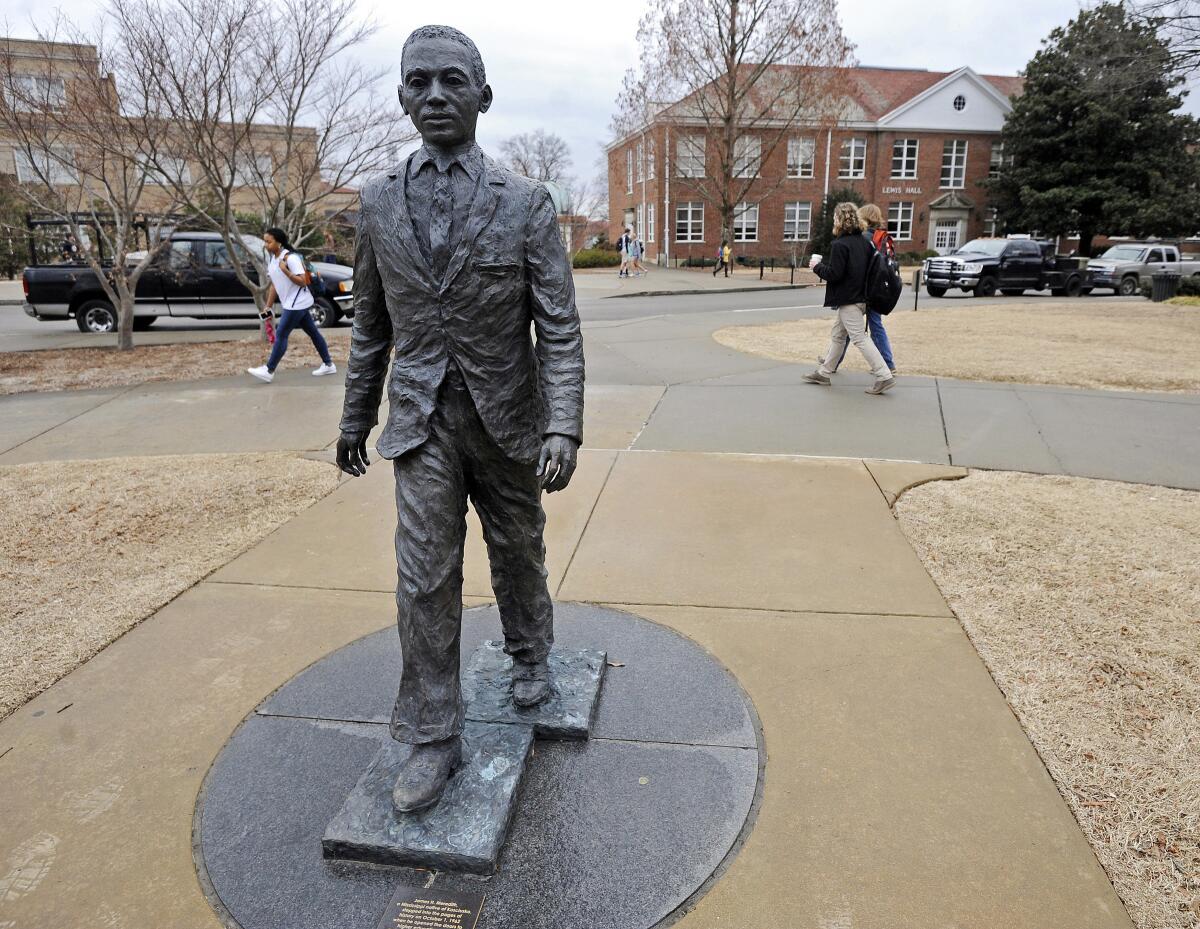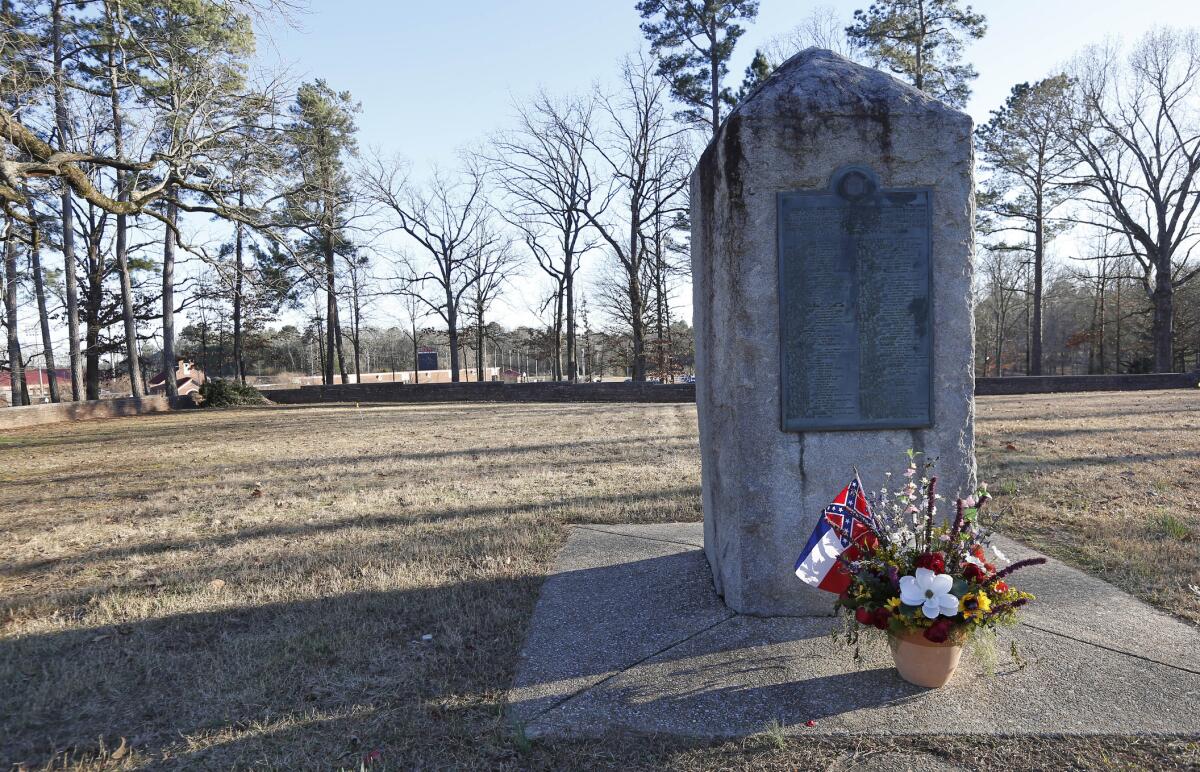Mississippi students voted to move a Civil War statue. Now they fear a Confederate shrine
- Share via
OXFORD, Miss. — When Joshua Mannery voted last year to remove a statue of a Confederate soldier that has towered over the heart of the University of Mississippi for more than a century, he understood that change takes place slowly on this historic Southern campus.
The 21-year-old Black student and president of the Associated Student Body did not imagine, however, that after waiting 15 months for the 29-foot monument to be relocated to a nearby Confederate cemetery, he would be marching through campus holding a placard that said “ABANDON THE PLANS!”
Now that construction crews have arrived on campus to move the white marble figure, student leaders are demanding that the project be halted after learning that university administrators plan to spend more than $1.1 million in private funds to renovate the cemetery and erect headstones for the Confederate dead, install security cameras and shine new lighting on the memorial.

“It just doesn’t seem normal that we have to protest the creation of a Confederate shrine — and yet here we are,” said Mannery, a fourth-year political science and English double major.
As the national conversation on race intensifies and Confederate symbols fall from prominent perches across the Deep South and beyond, this university that served as a makeshift hospital and morgue during the Civil War finds itself embroiled in yet another reckoning over its identity and traditions.
Black students — who make up just 12.5% of enrollment at the large public university, even though the state is about 38% Black — have become empowered to question deeply entrenched symbols on a campus that touts diversity and inclusion.
But even now, after weeks of national outrage over racism in the wake of the police killing of George Floyd in Minneapolis, they complain that university officials here are not listening.
“They’re like, ‘We hear you, but …,’” Mannery said. “We’re getting tired of ‘We hear you, but ….’”

Opposition to the Confederate monument, erected in 1906 by the United Daughters of the Confederacy, has been building for years.
In 2014, after a freshman placed a noose around the neck of a bronze statue honoring James Meredith, the first Black student to enroll at the segregated university in 1962 after the intervention of the federal government, administrators announced a plan to offer more historic context to the Confederate statue and other landmarks.
But when a plaque was unveiled in 2016, the National Assn. for the Advancement of Colored People pointed out it did not mention slavery as the central issue in the Civil War. A new plaque was installed, but many say it is not sufficiently prominent.
Mississippi law prohibits the destruction or removal of war memorials, so last year students and faculty leaders came up with what they thought was a compromise: relocating the statue half a mile across campus to a cemetery near the football practice field.
When administrators expressed support, it seemed there was broad consensus that the statue should no longer occupy a prime position on the campus where nearly a quarter of students are minorities and about 45% are from out of state.
So students were shocked to learn that university officials had devised a plan — without their input — to raise donor money to renovate the cemetery.
“We asked for something simple,” Mannery said. “We didn’t ask for them to solve racism. We’re just asking for a Confederate statue to be relocated. … And the fact that they can’t do that, without adding to it and beautifying it, it’s painful.”
In addition to adding headstones for the Confederate soldiers — a move that critics say is historically inaccurate as the exact number and names of soldiers buried is unknown — the university submitted artist renderings that show a newly laid path leading up to the contentious statue, which would be surrounded by manicured landscaping and in-ground lighting.
“Instead of addressing the problem, we’re now magnifying white supremacy and ultimately glorifying lost cause ideology,” said Arielle Hudson, 22, a recent Black graduate who co-wrote the resolution calling for the statue’s relocation.
***
Mannery hardly gave the white stone infantryman a passing thought when he enrolled as a freshman three years ago. Like many Black students who passed the soldier high up on a pedestal as he went to class, he figured it was a fixed part of the landscape, like the white-columned fraternity houses and grove of stately oak, elm and magnolia trees.
But as Mannery learned more about the history of the monument and watched the campaign to remove Confederate symbols get more buy-in as some students said they made them feel uncomfortable, he decided he had been too compliant.
“We know what it stands for: white supremacy and the exclusion of people that look like me,” he said. “To have it at the heart of campus, it’s like telling people to turn away and saying, ‘You’re not welcome here.’ It represents our inability to separate ourselves from the worst part of our history.”
MoMo Sanogo, a Black 21-year-old linebacker on the football team who has led protests on campus and in downtown Oxford in recent weeks, said he had been bothered by the monument when he enrolled in 2017. But until last month, he had not wanted to speak out, fearing he would get cut from the team and eventually go undrafted by the National Football League.
He has been encouraged, he said, after NFL Commissioner Roger Goodell condemned racism in the wake of protests against police brutality and apologized for not listening to Black players.
Meanwhile, the National Collegiate Athletic Assn. and the Southeastern Conference successfully pressured Mississippi lawmakers to finally lower its state flag dominated by the Confederate battle emblem and retire it to a museum.
“Now we’re in a place where it’s acceptable for us to use our voice and our platform and it won’t affect our future,” Sanogo said.
Last month, the state board that oversees Mississippi’s eight public universities finally approved the relocation — and students were in the midst of celebrating when they learned of the $1-million-plus cemetery beautification plan.
***

Debates about the meaning of Confederate statues have long raged across the South, with defenders insisting they are memorials to the dead while critics dismiss them as attempts to glorify the Confederacy and remind Black residents that whites were still in charge.
“This is a monument to boys who never came home,” said Starke Miller, a white local Civil War historian and tour guide, noting that a quarter of the men from Lafayette County who enlisted with the Confederacy died.
“We have over 20,000 students on campus,” he added. “If I told you 25% of those kids were dead, do you think we would put up a monument up for them?”
A new generation of historians, however, increasingly focus on how local politicians of the era fought to erect the monuments to bolster the cause of white supremacy.
Last month, Anne Twitty, a white associate professor of history at the university, uncovered the dedicatory address from the monument’s 1906 unveiling.
The soldiers’ “crowning glory,” a Mississippi attorney and candidate for governor told the crowd, was not during the war itself, but “during the nightmare called the Reconstruction” when they “boldly, aggressively and intentionally overrode the letter of the law, that they might maintain the spirit of the law and preserve Anglo-Saxon civilization.”
More than half a century later, white mobs opposing integration rioted in the shadow of the monument. Two civilians were killed.
As more Black students and faculty enrolled in subsequent years, the university has taken several steps to distance itself from offensive symbols.
In 1983, a year after the college’s first Black cheerleader refused to wave the Confederate battle flag, the school announced it would no longer hand out flags at football games. That didn’t stop fans from bringing their own, but in 1997, administrators banned sticks from athletic events, thus preventing game-goers from waving them anymore.
In the last decade, the college has also retired the Mississippi state flag, which until last week featured the Confederate battle emblem, asked its marching band to stop playing any variation of “Dixie,” the unofficial Confederate anthem, and renamed a street that was called “Confederate Drive.”
Some see the moving of the Confederate monument, along with the retiring of the state flag, as a historic climax.
“This is the last stage of great transformation in Southern symbolism and it’s a long time coming,” said Charles Reagan Wilson, professor emeritus of history at the university and former director of the Center for the Study of Southern Culture.
“It’s like the civil rights workers used to say: If you can break Mississippi, you can break the South,” Wilson added. “It’s the most extreme of the Southern states.”
Others see the relocating of the Confederate monument as no more than a step in dismantling a legacy of racism.
“It’s a good first gesture,” said Ethel Young-Scurlock, a Black professor of English and director of African American studies, who has worked at the university for 24 years.
The nickname for the university’s athletic teams, she noted, is still the Rebels and the university itself still goes by Ole Miss, a term that slaves used to refer to the wife of a plantation owner.
While some Black students and faculty refuse to use such terms because of the “tyrannical nature of that history,” Young-Scurlock said, others embrace them. On campus, there is spirited debate on whether such symbols and language should be done away with or can be given new meaning.
“The way politics is shifting, we just don’t know what is going to happen,” she said.
Even now, not all Black voices on campus care if the monument is moved.
“What’s the big deal?” asked Sharron Holley, 57, a Black custodian, as she sat at a picnic table one morning on a lunch break from her 3 a.m. shift and watched a security guard patrol a 10-foot privacy fence that has been erected around the statue. “It doesn’t harm anyone.”
Holley said she is more concerned about getting a pay raise than fighting a marble statue.
“It really doesn’t matter to me,” said Jesse Mullin, 50, a Black cook at the Rebel Market as he waited outside a transit center in the rain for a ride to his second job. “It’s honoring soldiers who died in the war. I don’t see it as a prop for racial discrimination.”
On the other hand, after waiting so long for university officials to relocate the monument, some activists feel that it is now time to remove it altogether.
“The Confederate monument has no place anywhere on our campus anymore,” professor Twitty said, noting that last month, Birmingham, Ala., removed a monument that is protected by state law on the basis that it was causing civil unrest.
Relocating the statue to the cemetery near the football practice field is unlikely to be a long-term fix, Twitty said. In the future, it could lead to protests from footballers or even a decision by the NCAA to ban any playoff games on campuses where there’s a Confederate monument.
“What seemed acceptable before is not where we are now,” Twitty said. “There’s a lot of people who think you make one bargain about this, and then it’s over. And the thing is, it’s never over. This is an evolving conversation about the symbols that we want to represent us.”
After meeting with the university chancellor Thursday, Mannery said student activists plan to increase the pressure on the university to halt the project — even if it means the monument won’t be removed before students return to campus in August.
“We’re just getting started,” he said. “We don’t want to be outside protesting a Confederate cemetery in the middle of the pandemic — that’s something out of a book — but now that we’ve accumulated so much buy-in, we want it done right.”
More to Read
Sign up for Essential California
The most important California stories and recommendations in your inbox every morning.
You may occasionally receive promotional content from the Los Angeles Times.











